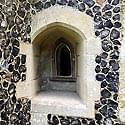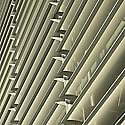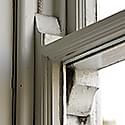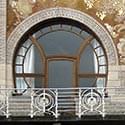
hagioscope, a squint or small opening between the high altar and the aisles or side chapels, ensuring that the priest would be visible at certain parts of a service [Greek: hagios, saint, holiness; scopos, target].
Eucharistic window has the same meaning, as do lychnoscope and loricula.
head, the uppermost component or feature of a frame or window opening.
head–mould, hood–mould, see drip–mould.

helioscene, a sun–screen or louvred awning in front of windows, allowing ventilation while keeping out the rays of the sun [Greek: helios, sun].
The use of the word ‘scene’ to mean ‘screen’ is first recorded in 1706, in connection with experiments in viewing the sun through a seven–foot telescope. See also brise–soleil.
hollow moulding, see scotia, cavetto.
horn (1), an early substitute for glass in windows.
In Holinshead’s Chronicles, 1577, in the chapter entitled Description of Britain and England, written by William Harrison, we read that ‘the Saxons . . . did make panels of horne in steede of glasse’. These were used also for lanterns. The process of heating and flattening ox horn is still carried on today, mostly to supply jewellers and comb makers with sheets up to 6 inches by 9 inches. Varying degrees of translucency can be obtained according to the process used, which may include splitting into thin sheets.
horn (2), projection of members of framed work as, for instance, the head and cill of a window frame or sub–frame.
As seen in this modern replacement window in a medieval timber–framed building.

horn (3), downward projection of the stiles of an upper sliding sash.
Usually finished with an ogee–shaped ‘flourish’. The purpose is to strengthen the mortise and tenon joint with the meeting rail, especially necessary after the introduction of larger and therefore much heavier glass panes following the repeal of the excise duty on glass in the middle of the nineteenth century. In some cases, as in the illustration, the stiles on the lower sash are carried upward. There is no logical reason for this, as there is no increased load on the sash.
hook stay, a metal rod, hooked at one end, to hold open a casement window.

horseshoe–arch, a semi–circular opening with arcs of a greater radius extending downward and inward.
Sometimes referred to as a keyhole–arch. An early horseshoe–arch can be seen at the Chaitya (assembly hall), Ajanta, Maharastra, India, dated 250 AD. The later history of this arch time seems to be inextricably bound up with the Visigoths (tribes of German nomads) and their wanderings over Europe from the end of the fourth century onward. Their use of this arch type in Spain is said to have influenced the later Arab conquerors of the country, leading to the tradition of horseshoe–arches in Islamic buildings in Spain and elsewhere. Most notable is the Great Mosque, Cordoba, Spain, (now a Christian church) where horseshoe–arches are constructed in alternating multiple brick and stone voussoirs. Later architects have used this arch type sparingly. The example shown, a house in the rue Defacqz, Brussels, Belgium, was built in 1897 for the artist Albert Ciamberlani (Photo: Colin Marr).


